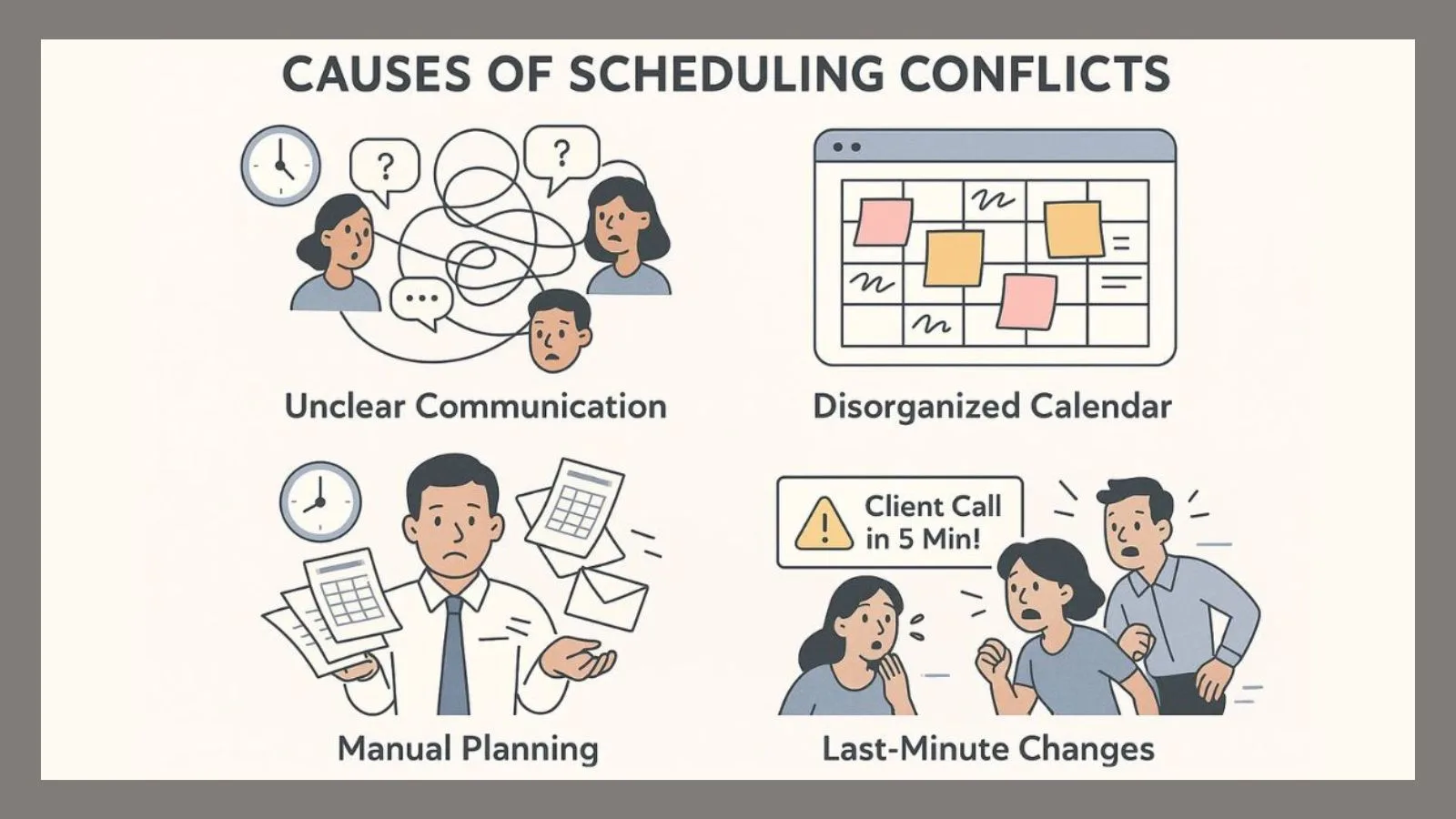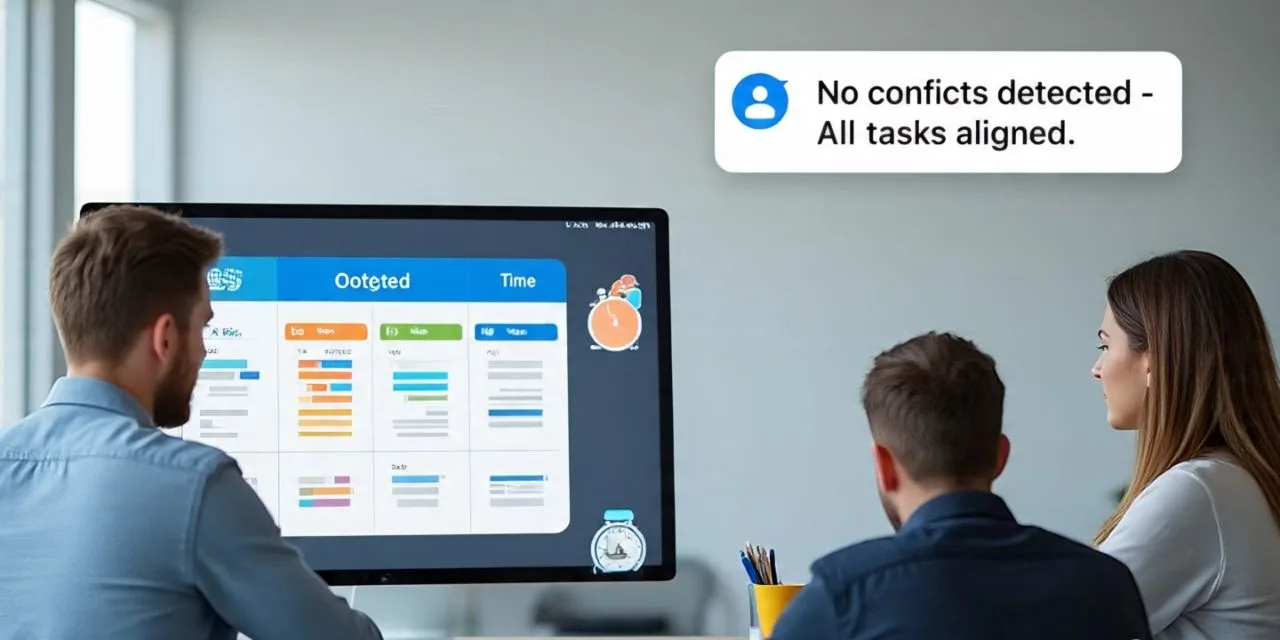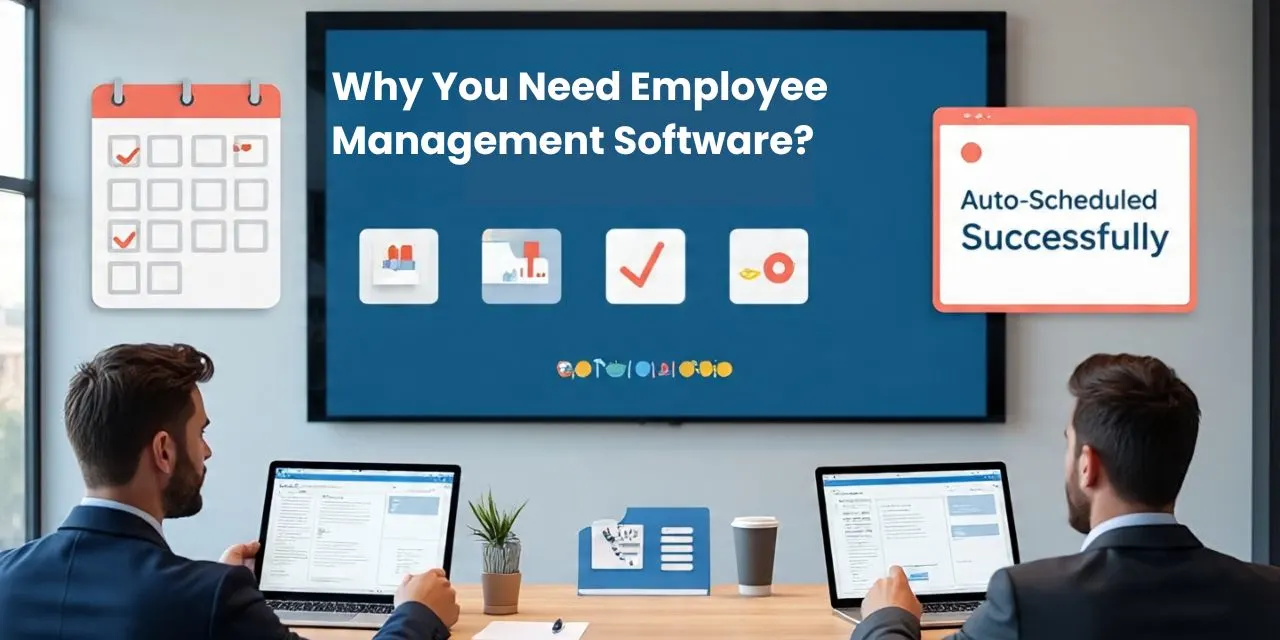A scheduling conflict might seem like a small issue, but it can quickly snowball into missed deadlines, team frustration, and lost productivity.
Whether it’s overlapping meetings, double-booked shifts, or unclear task ownership, these clashes disrupt daily operations and put pressure on your team’s workflow.
So, what is a scheduling conflict exactly?
It’s when two or more tasks, meetings, or responsibilities are scheduled for the same time, making it impossible for one person to attend to or complete them all.
These conflicts are especially common in growing teams or businesses still relying on manual planning.
The good news?
Most scheduling issues can be avoided with the right tools and planning strategies.
In this blog, we’ll break down what causes scheduling conflicts, how they impact your team, and the smartest ways to prevent them, so your team can stay in sync and on track.
In A Hurry! Listen To The Podcast Now:
What Is A Scheduling Conflict?
A scheduling conflict occurs when two or more tasks, meetings, or responsibilities are planned for the same time, making it impossible for a person to attend to or complete them all.
It’s one of the most common challenges teams face, especially in fast-paced or shift-based work environments.
Even a small overlap in schedules can cause missed deadlines, reduced productivity, or communication breakdowns.
So, what does scheduling conflict mean in a workplace setting?
In simple terms, it’s when your calendar has clashing appointments, making it difficult to manage your time effectively.
For example, if an employee is booked for a client call and a team meeting at the same time, that’s a scheduling conflict.
The scheduling conflict’s meaning can also extend to resource allocation.
If two teams require the same equipment or personnel at once, it creates a bottleneck. These conflicts often result from miscommunication, a lack of visibility, or outdated scheduling methods.
Understanding this concept is the first step toward eliminating inefficiencies.
With the right strategies and tools in place, scheduling conflicts can be minimized or even avoided entirely.
Common Causes Of Scheduling Conflicts:
In any workplace, efficient coordination is key to maintaining productivity. However, without proper systems in place, even the most organized teams can face unexpected challenges.
One such challenge is a scheduling conflict, which occurs when two or more tasks or meetings overlap, making it impossible for an employee to be in multiple places at once.
One of the most common causes is poor workplace coordination. When teams don’t communicate their availability or shift changes clearly, overlaps become inevitable.
Manual scheduling processes also contribute to errors, especially in growing teams where tracking everyone’s availability becomes difficult.
Another major issue is the lack of centralized tools. Relying on separate calendars, emails, or chat updates can result in missed details and double bookings.
Additionally, sudden changes like emergency leaves or last-minute client calls can throw the whole day’s plan off balance if there’s no flexible system in place to manage it.
Ultimately, these scheduling conflicts not only disrupt workflows but also affect employee satisfaction and team morale.
Identifying these root causes is the first step toward preventing them and building a more organized, stress-free work environment.
How Scheduling Conflicts Impact Your Team?
Even the most skilled teams can struggle when their schedules clash.
A scheduling conflict, such as double-booked meetings or overlapping shifts, can throw off your entire workflow.
It’s more than just a calendar issue; it directly affects how efficiently your team operates.
One of the first things to suffer is team productivity. When employees are unsure about where they need to be or when time is wasted, priorities are missed, and work gets delayed.
These delays often snowball into missed deadlines, especially when projects rely on collaborative efforts.
Over time, recurring conflicts lead to frustration. Employees may feel overwhelmed, undervalued, or simply confused about their responsibilities.
This gradually chips away at employee morale, making it harder to maintain a motivated and focused team.
A team that’s constantly battling scheduling issues loses trust in the process and leadership. Without proper visibility and coordination, even small tasks can become major roadblocks.
To keep your team running smoothly, it’s crucial to proactively address these challenges before they impact performance or culture.
Proven Ways To Prevent Scheduling Conflicts:
Avoiding scheduling conflict starts with smart planning and the right tools.
One of the most effective ways to prevent overlapping shifts or meetings is to use a centralized calendar where everyone on the team can see availability in real time.
This helps eliminate guesswork and double bookings.
Another key tip is to communicate clearly when setting deadlines, assigning tasks, or making changes to schedules. Keeping everyone in the loop reduces the risk of misalignment.
It’s also helpful to build buffer time between tasks or meetings, so your team isn’t constantly jumping from one thing to another.
This not only prevents scheduling clashes but also improves overall productivity.
Most importantly, automate your scheduling with reliable tools.
Manual processes often lead to errors, especially in larger teams or shift-based operations. Using workforce management software ensures better visibility and fewer conflicts.
Finally, review schedules regularly to spot any recurring issues or potential overlaps before they become a problem.
Prevention is always easier than fixing a conflict later.
By following these steps, you can create a more organized, efficient work environment, free from unnecessary scheduling stress.
Benefits Of Resolving Scheduling Conflicts Early:
Dealing with scheduling conflicts after they happen can cause unnecessary stress for both employees and managers.
That’s why resolving them early, or better yet, preventing them altogether, can make a big difference in your team’s performance and morale.
One major benefit is increased productivity.
When everyone knows where they need to be and when, tasks flow more smoothly, and time isn’t wasted on back-and-forth rescheduling.
It also helps build trust within the team, as employees feel their time and availability are respected.
Another important advantage is reduced burnout.
Overlapping shifts or last-minute changes can lead to overwork, fatigue, and eventually disengagement.
Fixing these issues early gives employees a sense of stability and balance.
Clients and stakeholders also notice the difference.
When schedules run efficiently, deadlines are met, meetings start on time, and the overall workflow looks more professional.
Finally, early Easy Conflict Resolution gives managers better control over resources and helps avoid costly last-minute adjustments.
Investing in proper workforce management tools can make this process easier and more accurate.
In short, solving scheduling conflicts early leads to a happier, more efficient, and better-aligned team.
Signs Your Team Is Struggling With Scheduling Conflicts:
Scheduling conflicts don’t always announce themselves; they quietly impact your team’s efficiency and morale over time.
Recognizing the warning signs early can help you take quick action before productivity takes a hit.
One of the most common red flags is frequent shift swaps or last-minute rescheduling.
If your team is constantly adjusting its hours or trading responsibilities, it may signal poor scheduling practices.
Another sign is missed meetings or double bookings. This often happens when there’s no centralized system in place to track availability, leading to overlapping tasks and confusion.
You might also notice a drop in team performance.
Deadlines get pushed, accountability weakens, and employees start feeling overwhelmed or burnt out, especially if they’re unknowingly overbooked.
Increased absenteeism can also be linked to scheduling stress.
When employees feel out of sync with their workload or colleagues, they’re less likely to stay engaged.
If these patterns sound familiar, it’s time to evaluate your scheduling process.
Adopting smarter tools like workforce management software can give you better visibility, improve coordination, and keep your team running smoothly, without the chaos of constant change. Why You Need Employee Management Software.
Also Read:
5 Easy Conflict Resolution Strategies For Workplace Success
The Best Guide To Work Scheduling Software
Why You Need Employee Management Software?
Managing a team without the right tools often leads to confusion, delays, and, most commonly, scheduling conflicts.
When you’re juggling multiple shifts, remote workers, and overlapping deadlines, relying on manual planning or spreadsheets just isn’t enough.
This is where employee management software becomes essential.
It gives you a centralized platform to track attendance, assign tasks, monitor availability, and plan shifts, without the risk of double-booking or scheduling errors.
By providing real-time visibility into who’s working when, you can make faster, more informed decisions that keep everyone aligned and productive.
In addition, modern workforce management software allows you to automate schedule updates, receive conflict alerts, and generate reports to optimize your planning.
This reduces administrative workload and boosts team efficiency.
If you’re struggling with disorganized schedules or missed handovers, it’s time to upgrade your process.
EmpMonitor helps you do exactly that.
With features like real-time attendance tracking, shift planning, and automated scheduling insights, it ensures your team runs like clockwork, no matter where they are.
Say goodbye to unnecessary overlaps and hello to smarter workforce coordination.
How Empmonitor Helps Eliminate Scheduling Conflicts?
Dealing with scheduling conflicts can slow down your team’s productivity and create unnecessary confusion.
That’s where a smart solution like EmpMonitor comes in.
Designed to simplify workforce coordination, EmpMonitor offers real-time visibility into employee activity, availability, and shift timings, making it easier to avoid overlapping tasks or missed assignments.
With its automated time tracking and attendance monitoring features, you’ll always know who is working, when they’re working, and how their time is being utilized.
This allows managers to plan shifts more effectively and assign tasks based on actual availability.
You can also track leave requests, break durations, and idle time, all in one centralized dashboard.
EmpMonitor plays a key role in preventing scheduling conflicts by offering smart project and task management features.
Managers can assign tasks, set deadlines, and monitor progress, all in one place.
With real-time monitoring, you get a live snapshot of what team members are currently working on, helping to avoid overlapping assignments or bottlenecks.
Additionally, its precise time tracking ensures better visibility into how long tasks take, so future schedules can be planned more accurately.
By aligning workloads with availability and current task status, EmpMonitor helps teams stay organized and efficient.
Conclusion:
Scheduling conflicts may seem like small issues, but they can snowball into major productivity losses and team frustration if not handled properly.
Whether it’s overlapping meetings, missed shifts, or misaligned tasks, these conflicts disrupt workflows and hurt team morale. They’re completely avoidable.
By understanding the root causes of scheduling conflicts and adopting better planning strategies, you can create a smoother, more efficient work environment.
Clear communication, flexible planning, and the use of modern tools all play a crucial role.
Most importantly, using workforce management software or employee management solutions helps reduce the risk of human error and ensures real-time visibility into everyone’s schedules.
When your team knows what’s expected, when to be available, and how tasks are distributed, everything runs like clockwork, and that’s the kind of workplace where people thrive.
Remember, preventing scheduling conflicts isn’t just about managing time; it’s about respecting your team’s time and building a culture of accountability and balance.
Take proactive steps today and start building a more productive, conflict-free workflow for your team.
FAQ’s:
Q1: What is a scheduling conflict?
A scheduling conflict happens when an employee is assigned two or more overlapping tasks, shifts, or meetings at the same time.
This prevents them from attending or completing all responsibilities effectively.
Q2: What causes scheduling conflicts at work?
Scheduling conflicts usually occur due to poor planning, lack of visibility into team calendars, manual errors, or last-minute changes.
Without proper workforce coordination, these mistakes can happen frequently.
Q3: How can scheduling conflicts affect team productivity?
Conflicts can lead to missed meetings, delayed tasks, or even unhappy clients.
For employees, it causes stress, confusion, and reduced job satisfaction, all of which hurt overall team performance.
Q4: What does scheduling conflict mean in shift-based jobs?
In shift-based roles like retail or healthcare, it means an employee is assigned to two shifts that overlap or don’t allow enough rest in between, leading to fatigue, burnout, and absenteeism.
Q5: Can software help prevent scheduling conflicts?
Absolutely. Employee management software can detect overlapping assignments, track real-time availability, and automate scheduling, ensuring every team member is assigned tasks without conflict.















